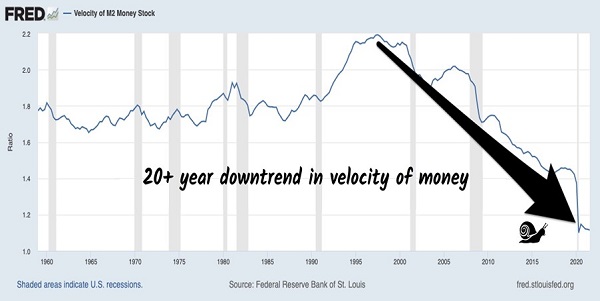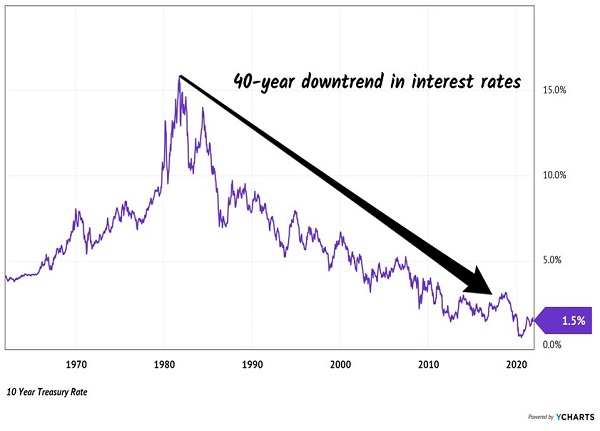The asset price “fuel” that our Federal Reserve has provided since March 2020 is going away soon. This will likely lead to continued volatility and a challenging backdrop for stocks-at-large.
Periodic “flights to safety” could benefit secure dividend stocks. We’ll touch on the outlook for income plays in a moment. First, let’s talk macro.
The stock market has been rallying for 21 months thanks to the Fed. It has gassed asset prices by buying trillions of dollars in bonds. (Note: “Bond buying” is a polite way of saying “money printing.” The bonds were using cash that Chairman Jay Powell created out of thin air.)
Jay would soon “slow” the Fed’s money printer to $120 billion per month. That was enough to sustain the S&P 500, America’s ticker. Some of the Fed’s cash also found its way into even more speculative corners such as “cryptocurrencies”—two of which have Shiba Inus front and center.
The Chairman was able to create this cash by stashing it on Fed books as IOUs, boosting the central bank’s balance sheet by a cool $4.5 trillion. The new money searched for return and drove up the prices of many assets, from real estate to stocks to crypto!
Our dividend stocks have directly benefited (and we don’t apologize for our profits!). We focused on “Fed-Fueled” payout plays that were helped by Jay’s money printing:
- Small bank Synovus (NYSE:SNV) has soared 173% since our April 2020 purchase in Contrarian Income Report. SNV has benefited from Powell keeping short-term rates on the floor.
- Railroad Canadian Pacific (NYSE:CP) has motored 61% higher since our April 2020 purchase in Hidden Yields. A few extra trillion sure sparked the global economy, bringing renewed demand for railroads.
- Landlord Preferred Apartment Communities (NYSE:APTS) has already popped 40% since our June 2021 buy in Dividend Swing Trader. This was a work-from-home-forever play, but we do appreciate Jay’s accommodative policy because his easy money went looking for a home in dividend stocks like APTS.
While I’m confident that we will continue to find “all-weather” stocks with solid dividends that will do well in 2022, “first-level” investors may not be so lucky. The growth of the Fed’s balance sheet has already begun to slow as Jay tries to taper his way out of the inflationary doghouse (by slowing the pace of money printing).
His near-term goal is to stop printing altogether. While noble, and probably necessary, a halt will mean less liquidity for financial assets. Going from $120 billion in new cash per month to (soon) zero would likely introduce serious volatility.
Jay doesn’t want downside. He likes it when the S&P is doing well. A steadily rising SPDR® S&P 500 (NYSE:SPY) makes Americans happy, because this is the only ticker in many basic investors’ retirement accounts.
Unfortunately for him, even though the S&P is near all-time highs, rising consumer prices have spoiled his stock party. A new CNBC poll reports inflation as the “number one concern for the country.” We can see this when Jay testifies in front of Congress—he gets grilled about rising prices. (Our typical congressperson may not do their own shopping, but they are hearing from their constituents who do.)
Yup, this holiday shopping season is ringing up quite the receipts. Inflation is now officially running hot per the consumer price index (CPI), a calculation that is designed to understate inflation. (For example, it doesn’t consider home prices, which are also soaring.) Still, the highest CPI since the early 1980s has been enough for Powell to admit that this inflation is not merely transitory (his words, not mine):
Inflation: More Than Transitory

Mr. and Ms. Market began to worry about tapering (less money printing) in September. They sold stocks then and repeated their unloading in November. Two selloffs in four months are troublesome signs for 2022. When the money faucets were flowing, we didn’t have to worry about inconveniences such as “corrections.” Now, we do.
But before we hunker down for a repeat of the inflationary 1970s, let me present my contrarian counterpoint. While Powell probably must stop printing so much money, I’m not sure he will need to follow his taper up with too many rate hikes (a modest two may suffice).
The reason that this inflationary fire should be relatively easy to put out is that the US economy is a mature economy. As a country, we just don’t spend like we used to, which is reflected in the “velocity” of money. And low velocity is a powerful deflationary force.
Velocity is a measure of how fast money changes hands. Everyone thinks one dollar is one dollar. But once it gets moving, it can pack more punch than “just a buck” and become inflationary. People feel confident and spend more on their next trip (the vacation they’ve been waiting a year for). The Airbnb host collects the cash and spends it elsewhere, the cleaner does the same. Round and round the dollar goes as it multiplies and creates price pressures.
This type of high money velocity is generally a prerequisite for inflation. But M2 money velocity has plummeted to post-World War II lows, in a downtrend for the past two-plus decades!
Money Moves Slower These Days

This downtrend in velocity is likewise reflected in 10-year Treasury rates, which have been moving lower for the last four decades:
Downtrend In Velocity? Downtrend In Interest Rates

With the recent inflation scares, I’ve heard from a few readers who are smartly asking if we should ditch our bonds before the Fed trashes the market. After all, Jay is a “whale” of a buyer starting to leave the fixed-income tables. And fixed-rate bonds don’t do well when interest rates rise.
But do rates need to rise that much to quell inflation? I don’t think so. A mere taper, plus a couple of interest rate hikes, may do the trick.
So, let’s not freak out. There’s no need to dump our high-quality dividend assets. We just need to make sure our income investments are fit for an “all-weather” environment, because we are likely to see wild swings in 2022.
I love “all-weather assets” that deliver income whether it’s a bull or bear market. Plus, I prefer a bit of price appreciation.
This is going to be a timely strategy in 2022 because, as liquidity dries up and speculators panic, they are going to look for safe, secure investments. Like our all-weather dividend stocks.
These flights to safety should work out well for us. We’ll use pullbacks to buy our favorite high-quality assets on the cheap. This is our profitable Fed-Fueled strategy upgraded and ready for 2022.
Disclosure: Brett Owens and Michael Foster are contrarian income investors who look for undervalued stocks/funds across the U.S. markets. Click here to learn how to profit from their strategies in the latest report, "7 Great Dividend Growth Stocks for a Secure Retirement."
